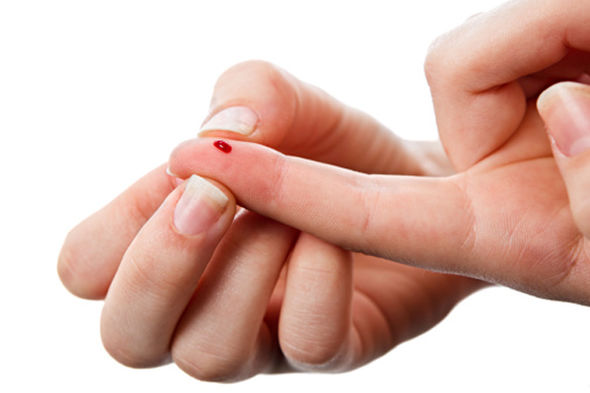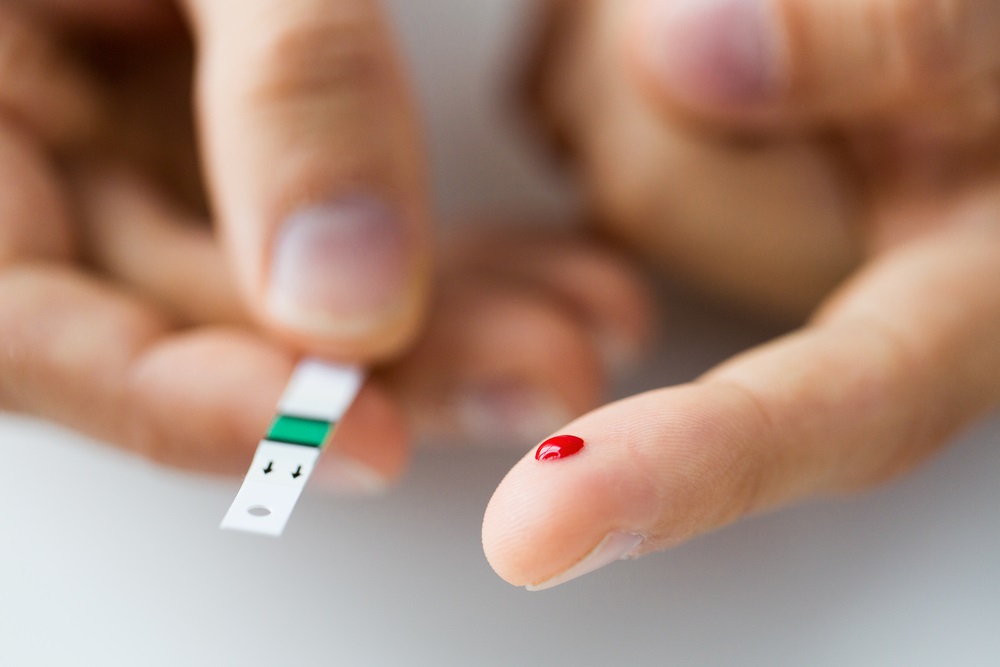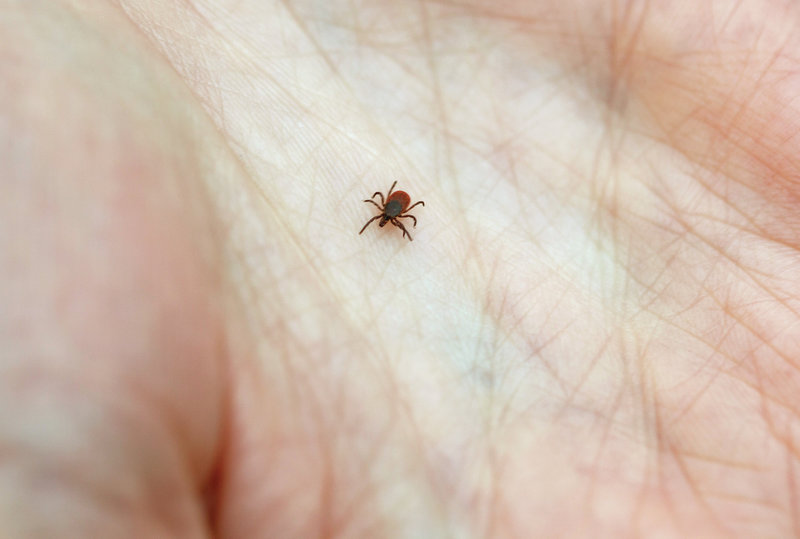Israeli Device Banishes Finger-Pricking for Sugar Levels in Diabetes Patients
Cnoga says it has created the first commercially available noninvasive glucose meter, using a camera and algorithms to read changes in fingers’ color.

Cnoga’s TensorTip device, also known as the CoG, allows an accurate and non-invasive monitoring of glucose levels in the blood (Courtesy)
Diabetes patients know that one of the greatest challenges in managing the ailment is tracking their blood sugar, or glucose, levels. To do that the only option available today is through the use of standard glucose meters — devices that require multiple finger pricks each day, a painful process.
For years, researchers have been trying to find a noninvasive, quicker and easier way to monitor blood glucose. Even the most advanced devices in use today, like needle sensors, which can track glucose continuously, need to be inserted under the skin every one to two weeks.
Now, Caesarea-based startup Cnoga Medical Ltd. says it has come up with a way to track blood glucose levels without pricking or pain. Its glucose meter, already approved for use in numerous countries worldwide, uses a camera to provide a diagnosis of blood glucose levels by observing the changing colors of the user’s finger.
During a short training period, the device learns to correlate the user’s skin tone with previous glucose level readings.
The technology got the green light on Monday from one of the world’s leading diabetes specialists, Prof. Andreas Pfützner, MD, PhD, who came to Israel to present the company with his findings after having tested the technology in two clinical studies in Germany.
“The results were surprising,” he told The Times of Israel in a phone interview. Pfützner held two clinical trials at his institute to validate the performance of the technology, and in both studies he found that the medical device performed “with a surprising level of accuracy,” the same as that of needle sensors.
“Cnoga achieved the same level of monitoring as the invasive devices,” he said.
“I have not seen this before,” he said. “It is a wonderful device” and a “true alternative” to current semi-invasive needle sensors used for treatment monitoring in patients with diabetes, he elaborated.
As managing director of the Pfützner Science & Health Institute, Diabetes Center & Practice in Mainz, Germany, Pfützner has performed more than 350 clinical studies as principal investigator, including more than 100 clinical research projects with diabetes-related technologies. He said he is not affiliated with the company but did get paid to perform the clinical trial, which is what is generally done.

Prof. Andreas Pfützner, managing director of the Pfützner Science & Health Institute, Diabetes Center & Practice in Mainz, Germany (Courtesy)
“Glucose measurement is a painful solution,” Pfützner said. Finding a way to monitor glucose without pain “is the most pressing unmet medical need in diabetes treatment.”
In his presentation on Monday, Pfützner said that the TensorTip device, also known as the CoG, developed by Cnoga provides noninvasive access to the blood sugar information. And in case of emergency or unclear results, an add-on regular blood sugar meter using test-strips may be used to confirm readings.
“In both studies, CoG was shown to reliably track blood sugar values when calibrated properly. The device performance was similar to results recently obtained with needle sensors, which have become very popular to track tissue glucose in a continuous fashion, and which are to be inserted under the skin every 7 to 14 days,” Pfützner said in his presentation of the trial results.
“In contrast, TensorTip is truly noninvasive and — after one week of intensive calibration — allows for pain-free access to an unlimited number of sugar readings every day without further need to replace disposable parts. The device can be used for more than two years and is therefore less costly when considering the entire period of use.”
“In consequence, TensorTip CoG may provide reliable glucose information on a daily basis. It is a true alternative to current semi-invasive needle sensors used for treatment monitoring in patients with diabetes.”
Every six seconds, a person dies from diabetes, and with 415 million sufferers globally, it will likely become the greatest epidemic in human history. It’s also one of the most costly diseases, amounting to 12 percent of annual healthcare expenditure worldwide.
Without accurate tracking, poorly controlled diabetes can easily lead to heart attacks, strokes, blindness, and reduced blood flow, which can cause serious limb infections and ultimately amputation. Very low blood glucose can also cause confusion, loss of consciousness and seizures.
First to market
“We are the first company in the world that has managed to build a noninvasive glucose meter that complies with global accuracy and quality standards,” said Cnoga’s VP of global sales and marketing Steven Macwan by phone. “This is the first commercial noninvasive glucose meter.”
The device has already received regulatory certifications from the European Union, Brazil and China and the company will start the process to attain US Food and Drug Administration approval in 2018, he said. “It was a strategic move to get the approvals in Europe and developing countries first,” as the process is shorter and less expensive, Macwan said.

Illustrative image of a diabetes patient measuring blood sugar levels (Maya23K, iStock by Getty Images)
Many companies tried to create noninvasive ways to monitor glucose but failed, he explained, because they tried to make a device that was universal – one device for all. Cnoga personalized its device, he said.
For the first week of use, the patients prick their fingers and take blood a few times a day with a regular glucose meter to help calibrate Cnoga’s device.
In that week, the software learns the characteristics of the body and collects data on the patient, like the color of the blood and how this changes over time in relation to the body’s glucose levels.
Once the device is calibrated, the patients insert their finger for some 40 seconds while an array of light-emitting-diodes (LED) shines light in wavelengths from visual to infrared through their fingertip. As the light waves pass through the fingertip, some of it is absorbed and some reflected. A camera sensor, similar to that found in professional digital cameras, detects the changes in the reflected light signal in real time.

Cnoga’s non-invasive glucose meter was found to be as accurate as the invasive, needle-based devices used in the market (Courtesy)
Using patented algorithms and the vast amount of data collected previously, the company’s software analyzes the correlation between the signal received and the patient’s bio parameters to provide a reading of the glucose level in the blood. This data is then displayed on the monitor at the back of the machine and can also be sent, by cloud or by cellphone, to the patients’ medical center.
The technology has not yet been approved for use by children, said Macwan, as the trials were conducted only on adults.
The product is already on sale, via the firm’s website, in countries like Germany, Italy and France, and will be available to Israelis by the end of the year, Macwan said. The end user price is around $1,000 to $1,500, he said.
Eyeing other uses
Using the same approach, of investigating the relationship between tissue color pigmentation and biological readings, the company is looking to provide noninvasive devices to monitor other vital signs.
By the end of the year it will start marketing its newest product, called the MTX, a pocket-sized, all-in-one self-monitoring system that can collect parameters like blood pressure, cardiac output, hemoglobin, pH, red blood cell count, and blood gases. Many of these parameters until now could only be measured through invasive tests conducted in specialists’ labs or at hospitals, and the technology can be of particular relevance to those who lives far from medical centers, the company said.
Set up in 2004, Cnoga was founded by entrepreneur Dr. Yosef Segman, a PhD in mathematics, whose previous startup, Oplus Technologies, sold to Intel for about $100 million. The firm has raised some $63 million to date, according to Start-up Nation Central, a nonprofit that tracks the industry. Investors include Texas Instruments, the BIRD Foundation, China’s Go Capital Ltd. and BOE Technology Group. Cnoga has offices in Shanghai and Sao Paolo.
Source: timesofisrael
“Israeli device banishes finger-pricking for sugar levels in diabetes patients”


